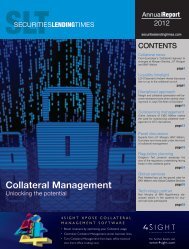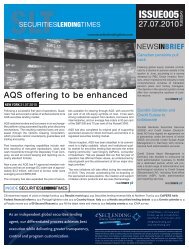ISSUE045 - Securities Lending Times
ISSUE045 - Securities Lending Times
ISSUE045 - Securities Lending Times
- No tags were found...
Create successful ePaper yourself
Turn your PDF publications into a flip-book with our unique Google optimized e-Paper software.
PanelDebateRaccat: As the majority of the working groupsand discussions are being chaired in Londonand Hong Kong these may assist in standardisingthe approach across some markets in Asia.That said, we have the impression that the localregulators across Asia feel that they haveappropriate levels of regulation in place andthis was evidenced by the robustness of Asianmarkets during the global financial crisis, so wemay have some recommendations adopted butnot others, as regulators continue to adopt ‘bestpractice’ but avoid any potentially negative impactsto their markets.Tomlinson: Asiaseems to be watchingwith interest as to howthe western marketsimplement the newrules and the effectthey will have ontheir marketsMcCardle: At present it does not seem fullyclear as to how the ongoing discussions of regulatoryor even legal changes that may come intoeffect this year will impact the global markets,including Asia. Regulatory changes are somethingthat have been a concern for many clientsover the past years in Asia - but regulators indifferent countries have decided to take differenttacks to try to insulate their economies frommany of the perceived downsides - to a thrivingsecurities lending market.Squillacioti: This is another area that many willbe keeping an eye on in the coming months. Forthe most part, regulatory reform has been relativelypositive in the Asian markets. As with thequestion of market improvement above, from aregulatory standpoint as well, it’s not really a homogeneousmarket and it’s to be expected thatyou would see differing developments in the variousmarkets. Asia has a mix of both developedsecurities lending markets and developing securitieslending markets. There are some marketsthat have been established for a few years makingcontinual tweaks and improvements. Thereare markets that are just beginning to exploreimplementing securities lending, such as Chinaand other markets that are reviewing changes toexisting models to make them accessible to offshoreparticipants. Market structures such as inTaiwan offer regulators and the exchange a highdegree of inherent transparency into the market.This probably serves as a way to mitigate theneed for the imposition of many other regulationsthat are seen in other markets. Hong Kongis a good example of a market that has beenan extremely favourable one from a regulatorystandpoint over the past several years, and webelieve serves as a model for other markets inthe region. All in all, directionally, the variousmarkets and regulators’ approach to securitieslending seems relatively positive.Tomlinson: Asia has always had various formsof market dependant regulation such as HongKong with the pre hold requirement (SLHK),which allowed it to perform favourably duringthe height of the credit crisis and avoid havingto enact any short selling bans. With the globalchanges taking place, Asia seems to be watchingwith interest as to how the western marketsimplement the new rules and the effect they willhave on their markets. Obviously the introductionof Basel III with its new capital, liquidityand leverage requirements will affect financialinstitutions everywhere and we expect to see acontinuation of the theme we are seeing in theUS and Europe to move towards equities andother types of securities as collateral and termup business where possible.SLT: What emerging markets aremaking significant moves forwardin terms of SBL?Rossler: Asia is one of the key growth regionsin the global securities lending market and, currently,Asian equities markets represent a significantshare of the total equities that are onloan. The utilisation rate is also higher on Asianequities than the rest of the equities markets.In terms of securities lending fees, some of thehighest fees are paid on Asian equities leadingto greater revenues for this activity.In Asia, local currency bond markets are underdevelopedcompared to their domestic equitymarkets. However, there are signs that this situationis beginning to change and many Asiancountries are making significant strides in developingtheir bond markets. As I mentioned earlier,the fact that local currency bond markets havedeepened significantly since the 1997 regionalcrisis, means that emerging Asian markets havebeen able to deal more effectively with the internationalcrisis this time around. Therefore, wewould also expect local bond markets acrossAsia to continue to develop and issuance indomestic currencies to increase, with a greaterdepth of domestic investment.24Daswani: Apart from Taiwan maintaining its positionas the priority emerging market for mostlenders in the region, recent changes in Malaysiaare likely to make it easier for offshore participantsto engage in this market.Contrary to an initial ruling, regulation waspassed in January 2012 to allow for lenders torecall loaned securities after selling those securitiesunder a securities lending transaction,subject to various conditions. This is a significantstep forward and participants are expectedto pursue actively lending in Malaysia, albeit thatuncertainty exists around revenue prospects atthis stage.Raccat: China, which if you combine the marketcapitalisation of the Shanghai and ShenzhenExchanges together are roughly the samesize as the London Stock Exchange. Howeverwe also continue to watch India, which is still asynthetic market, and would like to see somematerial developments given the growth of thislocal exchange which is now the 12th biggestexchange (by market capitalisation) globally.McCardle: In Asia the emerging markets that areof keen interest seem to be India and China.Squillacioti: Malaysia enhancing its offshoremodel is certainly evidence of making stridesas an ‘emerging’ market for securities lending.It presents some exciting opportunities. We alsocontinue to look at markets such as Indonesia’soffshore market, the Philippines, and Vietnam,which also currently seems to be exploring thepotential of SBL.Malaysia looks to be the next market that BNYMellon will be focusing on although Indonesiaalso seems to be making progress. We shouldnot forget India, which although it is currentlyvery restrictive, is definitely one we have our eyeon should the dialogue that is being had with theSEBI lead to any material developments.Rossler: Theutilisation rateis also higheron Asian equitiesthan the restof the equitiesmarketsBhatia: In short, China. As noted above, Chinais making strides in developing their domesticwww.securitieslendingtimes.com












